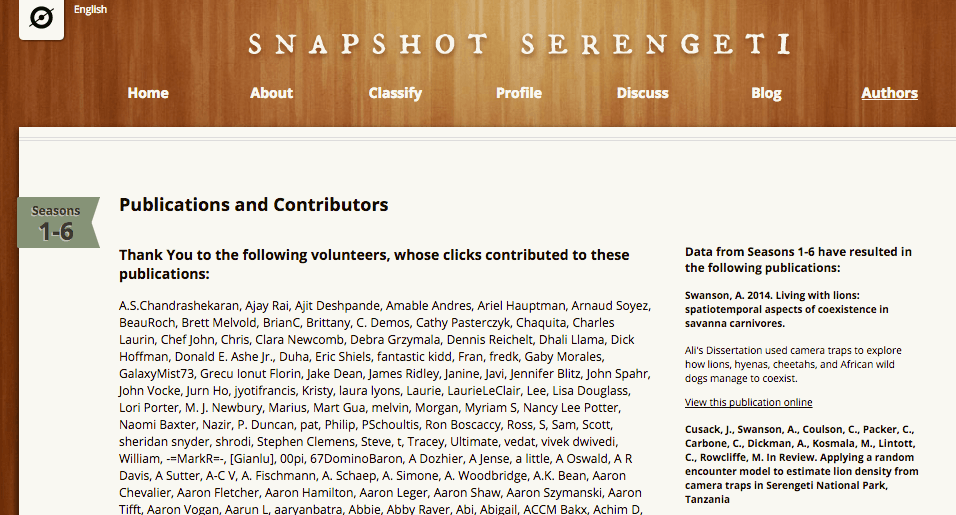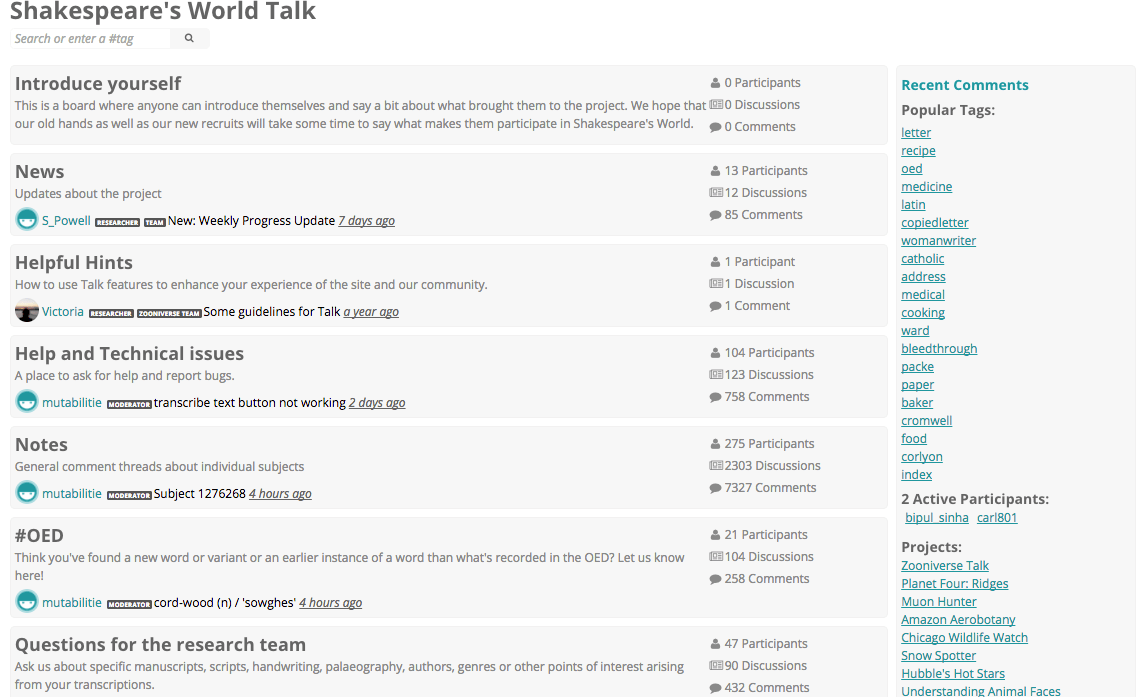Zooniverse: Scientific Research through Crowdsourcing

Zooniverse allows the general public to analyze scientific data and allows faster solving of big scientific problems.
Scientific analyses and discoveries have been restricted to experts in the past. Scientists are being bombarded with ever increasing data. Until now, computers have been doing a good job of analyzing this data. However, computers are good at only those analyses that can be codified. A lot of scientific research still relies on human intuition and skills that are difficult for a computer to replicate.
 Consider the challenge of classifying galaxies. Astronomers want to categorize many million galaxies (based on color and shape) in photos taken by the Hubble Space Telescope. While computers are great at identifying color in images, they struggle in identifying shape. However, identifying shapes is quite simple for humans. Astronomers could do it themselves but it is not a good usage of their expertise. Imagine a case in which scientists can use crowdsourcing and get help from normal people to categorize these galaxies. This project (known as Galaxy Zoo) is what Zooniverse started with and it has expanded to more than 50 scientific projects [1].
Consider the challenge of classifying galaxies. Astronomers want to categorize many million galaxies (based on color and shape) in photos taken by the Hubble Space Telescope. While computers are great at identifying color in images, they struggle in identifying shape. However, identifying shapes is quite simple for humans. Astronomers could do it themselves but it is not a good usage of their expertise. Imagine a case in which scientists can use crowdsourcing and get help from normal people to categorize these galaxies. This project (known as Galaxy Zoo) is what Zooniverse started with and it has expanded to more than 50 scientific projects [1].
Exhibit 1: Galaxies can be categorized into different shape categories by asking users
What is Zooniverse?
Zooniverse is a website that connects scientists with research collaborators. Research collaborators are normal people and no specific expertise is expected of them. Zooniverse’s first project was Galaxy Zoo (described above) [2] and the website has now expanded to initiatives that includes monitoring climate change, monitoring sea lion population and transcribing handwritten texts.
Exhibit 2: Sample projects on Zooniverse
Managing and incentivizing participation:
Zooniverse’s community consists of more than 1Mn members [3]. It has certain features that incentivizes participation:
- No prior expertise is needed for joining
- Researchers that publish projects are asked to break the project into pieces that can be analyzed by anyone. For e.g. classifying shape in an image or transcribing handwritten text
- Taps into the collaborators’ desire to be part of solving big problems in science and environment. All the collaborators are acknowledged if the project leads to a scientific paper
“Every galaxy has a story to tell. They are beautiful, mysterious, and show how amazing our universe is. It was love at first sight when I started in Galaxy Zoo … It is a magical place, and it feels like coming home at last.” – Aida Berges, a popular contributor on Zooniverse’s Galaxy Zoo Project [4]
Exhibit 3: Long list of collaborators on Zooniverse’s “Snapshot Serengeti” project
- No minimum time commitment. For e.g. collaborators can categorize just 1 image or can categorize 1000s of them
A few features helps in managing the contribution of the crowd:
- Verification by other collaborators to ensure accuracy. Every task/ contribution is obtained from 50 different people on an average and the database is populated only if a significant portion of these contributions match
- Active community forum for collaborators to discuss the project as well as related topics. The Galaxy Zoo project forum led to more than 650,000 posts [2]
Exhibit 4: Community forum on Zooniverse’s “Shakespeare’s World” project – a project for transcribing handwritten text
Creating and Capturing value
Zooniverse creates value by playing a role in solving scientific problems. Researchers get access to an army of “free interns” to work on problems that are simple for humans but can’t be solved by computers. The Zooniverse community creates 50 years of effort per annum [5][6].
The value of this is clear from the 125+ scientific papers and publications that have been published as a direct result of Zooniverse projects [7]. It has also led to completely new scientific discoveries like Hanny’s Voorwerp and Pea galaxy.
Zooniverse does not capture this value at present. Most of this value is captured by the researchers that post their projects on the website and benefit from the collaborators or “free interns”. Zooniverse saved research groups $220,000 per project on average [8]. It can potentially capture value from this model in the future through:
- Charging researchers a fee for listing their project on zooniverse.com. The fee could be determined by the # of collaborators or the amount of man-hours work that Zooniverse is able to source
- License fees from the databases that are created in Zooniverse
Future growth potential:
Due to Internet of Things, the data that we collect from our environment will only increase. We have discussed that existing computing technology is unable to analyze some of this data. Hence, Zooniverse’s approach of crowdsourcing to analyze scientific data will find greater potential in the future. However, there are some concerns too. The top 10% contributors end up doing 80% of the work [8]. Some projects are not interesting enough and only few collaborators join. Zooniverse would need to overcome these challenges to continue being successful in the future.
*********************************************************************************************************
Sources:
[1] https://www.zooniverse.org/projects?status=live
[2] https://en.wikipedia.org/wiki/Galaxy_Zoo
[3] http://www.wired.co.uk/article/science-as-a-game
[4] http://content.time.com/time/health/article/0,8599,1975296,00.html
[5] http://www.wired.co.uk/article/science-as-a-game
[6] http://yalescientific.org/thescope/2016/04/the-scientist-in-us-all-how-crowdsourcing-in-science-is-changing-the-world/
[7] https://www.zooniverse.org/about/publications
[8] https://arstechnica.com/science/2015/01/most-participants-in-citizen-science-projects-give-up-almost-immediately/






Great post Bipul! Really like the fact that they emphasise the importance contribution from the volunteers and give recognition to their work. On your future monetisation point, do you think they will have to start paying their volunteers if they start making money directly from the listing fee/ project?
Thanks Anish! Very relevant question. Yes, I think they would need to start paying their volunteers if they are also raising money from the research groups. For e.g. if they are able to get $5 for every man-hour work that they are able to source for the research group, then I can imagine them giving out $3 to the actual volunteers and keep $2 for themselves. In this way they will continue creating value for all the stakeholders: (1) research groups can still access talent at a rate of $5 per hour compared to minimum wage of around $10 in US; (2) volunteers can earn some money from this and at the same time benefit from the game like aspect of these projects and the recognition they get